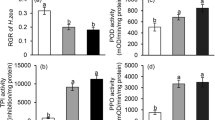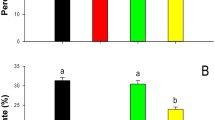Abstract
Optical brighteners cansynergistically enhance nucleopolyhedrovirusinfectivity to lepidopteran larvae by blockingthe sloughing of infected primary midgut cellsand inhibiting the formation of the peritrophicmembrane in the hosts. Because of similaritiesin the route of infection, we investigatedwhether optical brighteners would also enhanceinfection with the milky disease bacterium,Paenibacillus popilliae, of Japanesebeetle, Popillia japonica, larvae. Thelarvae were kept in soil mixed with P.popilliae spore preparations and the opticalbrighteners Blankophor BBH, P167, or RKH withperennial ryegrass provided as food. Noenhancing effect of any of the opticalbrighteners on P. popilliae infection wasobserved at a concentration of 0.1% (w/w). Rather, when mixed into the soil at 0.02, 0.1,or 0.5% (w/w) BBH reduced P. popilliaeinfection at the highest rate.
Similar content being viewed by others
References
Abbott, W.S., 1925. A method for computing the effectiveness of an insecticide. J. Econ. Entomol. 18: 265–267.
Dingman, D.W., 1996. Description and use of a peroral infection technique for studying milky disease. J. Invertebr. Pathol. 67: 102–104.
Dutky, S.R., 1963. Themilky diseases. In: E.A. Steinhaus (ed), Insect Pathology: An Advanced Treatise, vol. 2. Academic Press, New York, USA. pp. 75–115.
Farrar, R.R., Jr. and R.L. Ridgway, 1997. The celery looper (Lepidoptera: Noctuidae) baculovirus: potency and enhancement by Blankophor BBH against 3 lepidopteran species. Environ. Entomol. 26: 1461–1469.
Finney, D.J., 1964. Probit analysis. Cambridge University Press, London, UK.
Fleming, W.E., 1968. Biological control of the Japanese beetle. U.S. Dept. Agric. Techn. Bull. 1383, U.S. Department of Agriculture, Washington, DC, USA.
Fleming, W.E. and T.L. Ladd, 1979. Milky disease for control of Japanese beetle. U.S. Dept. Agric. Leafl. 500. U.S. Department of Agriculture, Washington, DC, USA.
Klein, M.G., 1992. Use of Bacillus popilliae in Japanese beetle control. In: T.R. Glare and T.A. Jackson (eds), Use of Pathogens in Scarab Pest Management. Intercept, Andover, England. pp. 179–189.
Koppenhöfer, A.M. and H.K. Kaya, 1998. Synergism of imidacloprid and an entomopathogenic nematode: a novel approach to white grub control in turfgrass. J. Econ. Entomol. 91: 618–623.
Li, S.Y. and I.S. Otvos, 1999. Optical brighteners enhance activity of a nuclear polyhedrosis virus against Western spruce budworm (Lepidoptera: Tortricidae). J. Econ. Entomol. 92: 335–339.
McVay, J.R., R.T. Gudauskas and J.D. Harper, 1977. Effects of Bacillus thuringiensis nuclearpolyhedrosis virus mixtures on Trichoplusia ni larvae. J. Invertebr. Pathol. 29: 367–372.
Pettersson, B., K.E. Rippere, A.A. Yousten and F.G. Priest, 1999. Transfer of Bacillus lentimorbus and Bacillus popilliae to the genus Paenibacillus with emended descriptions of Paenibacillus lentimorbus comb. nov. and Paenibacillus popilliae comb. nov. Int. J. Systemat. Bacteriol. 49: 531–540.
SAS Institute, 1996. SAS 6.11 for Windows. SAS Institute Inc., Cary, NC, USA.
Sharpe, E.S. and R.W. Detroy, 1979. Fat body depletion, a debilitating result of milky disease in Japanese beetle larvae. J. Invertebr. Pathol. 34: 92–94.
Splittstoesser, C.M., C.Y. Kawanishi and H. Tashiro, 1978. Infection of the European chafer, Amphimallon majalis by Bacillus popilliae light and electron microscope observations. J. Invertebr. Pathol. 31: 84–90.
Wang, P. and R.R. Granados, 2000. Calcofluor disrupts the midgut defense system in insects. Insect Biochem. Molec. Biol. 30: 135–143.
Wang, Y., J.F. Campbell and R. Gaugler, 1995. Infection of entomopathogenic nematodes Steinernema glaseri and Heterorhabditis bacteriophora against Popillia japonica (Coleoptera Scarabaeidae) larvae. J. Invertebr. Pathol. 66: 178–184.
Washburn, J.O., B.A. Kirkpatrick, E. Haas-Stapleton and L.E. Volkman, 1998. Evidence that the stilbene-derived optical brightener M2R enhances Autographa californica m nucleopolyhedrovirus infection of Trichoplusia ni and Heliothis virescens by preventing sloughing of infected midgut epithelial cells. Biol. Control 11: 58–69.
Webb, R.E.M., M. Shapiro, J.D. Podgwaite, R.L. Ridgway, L. Venables, G.B. White, R.J. Argauer, D.L. Cohen, J. Witcosky, K.M. Lester and K.W. Thorpe, 1994. Effect of optical brightener on the efficacy of gypsy moth (Lepidoptera Lymantriidae) nuclear polyhedrosis virus in forest plots with high or low levels of natural virus. J. Econ. Entomol. 87: 134–143.
Zhang, J., T.C. Hodgman, L. Krieger, W. Schnetter and H.U. Schairer, 1997. Cloning and analysis of the first cry gene from Bacillus popilliae. J. Bacteriol. 179: 4336–4341.
Author information
Authors and Affiliations
Corresponding author
Rights and permissions
About this article
Cite this article
Koppenhöfer, A.M., Fuzy, E.M. Lack of interaction between the milky disease bacterium Paenibacillus popilliae and stilbene-derived optical brighteners in Japanese beetle larvae. BioControl 47, 707–714 (2002). https://doi.org/10.1023/A:1020567600823
Issue Date:
DOI: https://doi.org/10.1023/A:1020567600823




